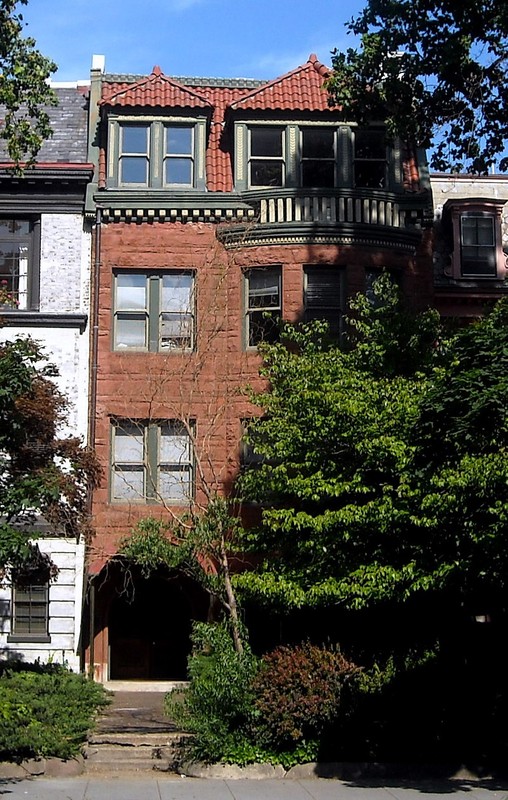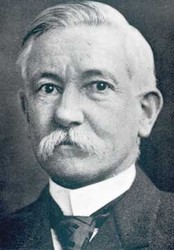Robert Simpson Woodward House
Introduction
Text-to-speech Audio
The second president of the Carnegie Institution, Robert Simpson Woodward (1849-1924), lived in this house from 1904 to 1914. Woodward was a geologist, civil engineer, and mathematician who made significant contributions to science over the course of his career, particularly in the field of geology and in scientific experimentation. He was also a skilled administrator. The house itself is believed to have been built around 1885 and was eventually divided into apartments. It was added to the National Register of Historic Places and designated a National Historic Landmark in 1976 for its association with Woodward.
Images
Robert Simpson Woodward lived in this house, which is now apartments, from 1904 to 1914 when he served as president of the Carnegie Institution.

Robert Simpson Woodward (1849-1924)

Backstory and Context
Text-to-speech Audio
Robert Simpson Woodward was born on July 21, 1849 on a farm in Rochester, Michigan. His father, Lysander, was a leading figure in the community. He not only ran the farm, he also held positions in the local county government, served as the president of the Oakland County Agricultural Society, and was the first president of the Detroit and Bay City Railroad. Lysander was also known for taking a scientific approach to agriculture, an interest he imparted onto Woodward.
After graduating from Rochester Academy in 1868, Woodward enrolled in the University of Michigan where he studied civil engineering. He spent the next three summers working for the United States Lake Survey and after graduating in 1872, got a job with the Survey. Over the the next ten years, he surveyed the Great Lakes and it was during that time that he became interested in geology. Woodward also married his wife, Martha, in 1876; they had three sons, Robert Jr., Karl, and William.
In 1882, he was appointed as an assistant astronomer to the United States Transit of Venus Commission. The U.S. Geological Survey (USGS) hired him two years later as an astronomer and he later became chief geographer and led the Division of Mathematics. Woodward made his most important scientific contributions while working for the USGS. His work included computing latitudes and longitudes used in making maps and studying sea level and geology. He was particularly interested in determining the age of the earth and used his knowledge of math, astronomy, and physics to support a hypothesis that the earth is 200-400 million years old. Although this conclusion is now known to be wrong, Woodward's work sparked new ways to study geology. In 1890, Woodward started working for the U.S. Coast and Geodetic Survey where he developed new, cheaper surveying techniques. Three years later, he became a professor of mechanics at Columbia University. He also served as dean of the College of Pure Science and, between 1897 to 1898, as vice president and president of the American Mathematical Society.
Philanthropist and steel magnate Andrew Carnegie donated $10 million to establish the Carnegie Institution in 1902 to promote scientific research. Woodward was named its second president in 1904 and during his tenure the organization directed funds to departments of research (within the Institution) instead of individuals, which is what it did originally. Woodward retired from the Institution in 1920 and died four years later in Washington D.C.
Over the course of his career, Woodward published over a 100 papers, edited a standard math textbook, and received many honors and awards. He was also a member of the National Academy of Sciences and served as president of American Association for the Advancement of Science, the New York Academy of Sciences, the Philosophical Society of Washington, and the Washington Academy of Sciences. Woodward also received honorary degrees from several universities.
Cite This Entry
M., Ben. "Robert Simpson Woodward House." Clio: Your Guide to History. November 3, 2022. Accessed April 12, 2025. https://theclio.com/tour/353/27/reverse
Sources
O'Connor, J.J. & Roberston, E.F. "Robert Simpson Woodward." School of Mathematics and Statistics, University of St. Andrews. April 2009.
Sheire, Mrs. James. "Robert Simpson Woodward." National Park Service - National Register of Historic Places Nomination Form. https://npgallery.nps.gov/NRHP/GetAsset/NHLS/76002136_text.
"Our History." Carnegie Institution for Science. Accessed November 3, 2022. https://carnegiescience.edu/about/history.
Both images via Wikimedia Commons

